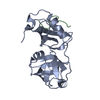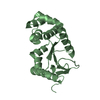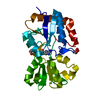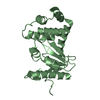| Entry | Database: PDB / ID: 5b6c
|
|---|
| Title | Structural Details of Ufd1 binding to p97 |
|---|
 Components Components | - Peptide from Ubiquitin fusion degradation protein 1 homolog
 - Transitional endoplasmic reticulum ATPase
|
|---|
 Keywords Keywords | HYDROLASE/PROTEIN BINDING / Ufd1 / SHP box / p97 / HYDROLASE-PROTEIN BINDING complex |
|---|
| Function / homology |  Function and homology information Function and homology information
UFD1-NPL4 complex / negative regulation of RIG-I signaling pathway / positive regulation of Lys63-specific deubiquitinase activity / flavin adenine dinucleotide catabolic process / positive regulation of oxidative phosphorylation / VCP-NSFL1C complex / endosome to lysosome transport via multivesicular body sorting pathway / protein-DNA covalent cross-linking repair / endoplasmic reticulum stress-induced pre-emptive quality control / cellular response to arsenite ion ...UFD1-NPL4 complex / negative regulation of RIG-I signaling pathway / positive regulation of Lys63-specific deubiquitinase activity / flavin adenine dinucleotide catabolic process / positive regulation of oxidative phosphorylation / VCP-NSFL1C complex / endosome to lysosome transport via multivesicular body sorting pathway / protein-DNA covalent cross-linking repair / endoplasmic reticulum stress-induced pre-emptive quality control / cellular response to arsenite ion / Derlin-1 retrotranslocation complex / BAT3 complex binding / positive regulation of protein K63-linked deubiquitination / deubiquitinase activator activity / mitotic spindle disassembly / VCP-NPL4-UFD1 AAA ATPase complex /  aggresome assembly / regulation of protein localization to chromatin / aggresome assembly / regulation of protein localization to chromatin /  vesicle-fusing ATPase / NADH metabolic process / cellular response to misfolded protein / stress granule disassembly / K48-linked polyubiquitin modification-dependent protein binding / positive regulation of mitochondrial membrane potential / negative regulation of protein localization to chromatin / ubiquitin-modified protein reader activity / retrograde protein transport, ER to cytosol / negative regulation of type I interferon production / vesicle-fusing ATPase / NADH metabolic process / cellular response to misfolded protein / stress granule disassembly / K48-linked polyubiquitin modification-dependent protein binding / positive regulation of mitochondrial membrane potential / negative regulation of protein localization to chromatin / ubiquitin-modified protein reader activity / retrograde protein transport, ER to cytosol / negative regulation of type I interferon production /  regulation of aerobic respiration / regulation of aerobic respiration /  ATPase complex / regulation of synapse organization / ubiquitin-specific protease binding / positive regulation of ATP biosynthetic process / ERAD pathway / ubiquitin-like protein ligase binding / MHC class I protein binding / autophagosome maturation / RHOH GTPase cycle / polyubiquitin modification-dependent protein binding / HSF1 activation / ATPase complex / regulation of synapse organization / ubiquitin-specific protease binding / positive regulation of ATP biosynthetic process / ERAD pathway / ubiquitin-like protein ligase binding / MHC class I protein binding / autophagosome maturation / RHOH GTPase cycle / polyubiquitin modification-dependent protein binding / HSF1 activation /  translesion synthesis / translesion synthesis /  Protein methylation / endoplasmic reticulum to Golgi vesicle-mediated transport / interstrand cross-link repair / negative regulation of smoothened signaling pathway / ATP metabolic process / Attachment and Entry / endoplasmic reticulum unfolded protein response / viral genome replication / Protein methylation / endoplasmic reticulum to Golgi vesicle-mediated transport / interstrand cross-link repair / negative regulation of smoothened signaling pathway / ATP metabolic process / Attachment and Entry / endoplasmic reticulum unfolded protein response / viral genome replication /  lipid droplet / lipid droplet /  proteasome complex / proteasomal protein catabolic process / Josephin domain DUBs / N-glycan trimming in the ER and Calnexin/Calreticulin cycle / proteasome complex / proteasomal protein catabolic process / Josephin domain DUBs / N-glycan trimming in the ER and Calnexin/Calreticulin cycle /  skeletal system development / Hh mutants are degraded by ERAD / Defective CFTR causes cystic fibrosis / Hedgehog ligand biogenesis / skeletal system development / Hh mutants are degraded by ERAD / Defective CFTR causes cystic fibrosis / Hedgehog ligand biogenesis /  macroautophagy / Translesion Synthesis by POLH / positive regulation of protein-containing complex assembly / ABC-family proteins mediated transport / establishment of protein localization / macroautophagy / Translesion Synthesis by POLH / positive regulation of protein-containing complex assembly / ABC-family proteins mediated transport / establishment of protein localization /  ADP binding / ADP binding /  autophagy / Aggrephagy / cytoplasmic stress granule / positive regulation of non-canonical NF-kappaB signal transduction / positive regulation of protein catabolic process / activation of cysteine-type endopeptidase activity involved in apoptotic process / KEAP1-NFE2L2 pathway / azurophil granule lumen / double-strand break repair / positive regulation of canonical Wnt signaling pathway / Ovarian tumor domain proteases / positive regulation of proteasomal ubiquitin-dependent protein catabolic process / E3 ubiquitin ligases ubiquitinate target proteins / site of double-strand break / autophagy / Aggrephagy / cytoplasmic stress granule / positive regulation of non-canonical NF-kappaB signal transduction / positive regulation of protein catabolic process / activation of cysteine-type endopeptidase activity involved in apoptotic process / KEAP1-NFE2L2 pathway / azurophil granule lumen / double-strand break repair / positive regulation of canonical Wnt signaling pathway / Ovarian tumor domain proteases / positive regulation of proteasomal ubiquitin-dependent protein catabolic process / E3 ubiquitin ligases ubiquitinate target proteins / site of double-strand break /  Neddylation / cellular response to heat / ubiquitin-dependent protein catabolic process / regulation of apoptotic process / Neddylation / cellular response to heat / ubiquitin-dependent protein catabolic process / regulation of apoptotic process /  protein phosphatase binding / proteasome-mediated ubiquitin-dependent protein catabolic process / secretory granule lumen / ficolin-1-rich granule lumen / cysteine-type deubiquitinase activity / Attachment and Entry / Ub-specific processing proteases / protein ubiquitination / protein domain specific binding / intracellular membrane-bounded organelle / protein phosphatase binding / proteasome-mediated ubiquitin-dependent protein catabolic process / secretory granule lumen / ficolin-1-rich granule lumen / cysteine-type deubiquitinase activity / Attachment and Entry / Ub-specific processing proteases / protein ubiquitination / protein domain specific binding / intracellular membrane-bounded organelle /  DNA repair / glutamatergic synapse / DNA repair / glutamatergic synapse /  lipid binding / DNA damage response / lipid binding / DNA damage response /  ubiquitin protein ligase binding / Neutrophil degranulation / endoplasmic reticulum membrane / perinuclear region of cytoplasmSimilarity search - Function ubiquitin protein ligase binding / Neutrophil degranulation / endoplasmic reticulum membrane / perinuclear region of cytoplasmSimilarity search - Function Ubiquitin fusion degradation protein Ufd1-like / Ufd1-like, Nn domain / Ubiquitin fusion degradation protein UFD1 / Vcp-like ATPase; Chain A, domain 2 - #10 / Vcp-like ATPase; Chain A, domain 2 / Barwin-like endoglucanases - #20 /  AAA ATPase, CDC48 family / Barwin-like endoglucanases / AAA ATPase, CDC48 family / Barwin-like endoglucanases /  Cell division protein 48 (CDC48), N-terminal domain / CDC48, N-terminal subdomain ...Ubiquitin fusion degradation protein Ufd1-like / Ufd1-like, Nn domain / Ubiquitin fusion degradation protein UFD1 / Vcp-like ATPase; Chain A, domain 2 - #10 / Vcp-like ATPase; Chain A, domain 2 / Barwin-like endoglucanases - #20 / Cell division protein 48 (CDC48), N-terminal domain / CDC48, N-terminal subdomain ...Ubiquitin fusion degradation protein Ufd1-like / Ufd1-like, Nn domain / Ubiquitin fusion degradation protein UFD1 / Vcp-like ATPase; Chain A, domain 2 - #10 / Vcp-like ATPase; Chain A, domain 2 / Barwin-like endoglucanases - #20 /  AAA ATPase, CDC48 family / Barwin-like endoglucanases / AAA ATPase, CDC48 family / Barwin-like endoglucanases /  Cell division protein 48 (CDC48), N-terminal domain / CDC48, N-terminal subdomain / Cell division protein 48 (CDC48), N-terminal domain / CDC48, N-terminal subdomain /  Cell division protein 48 (CDC48) N-terminal domain / CDC48, domain 2 / Cell division protein 48 (CDC48) N-terminal domain / CDC48, domain 2 /  Cell division protein 48 (CDC48), domain 2 / Cell division protein 48 (CDC48), domain 2 /  Cell division protein 48 (CDC48) domain 2 / CDC48 domain 2-like superfamily / Aspartate decarboxylase-like domain superfamily / Cell division protein 48 (CDC48) domain 2 / CDC48 domain 2-like superfamily / Aspartate decarboxylase-like domain superfamily /  AAA ATPase, AAA+ lid domain / AAA+ lid domain / AAA ATPase, AAA+ lid domain / AAA+ lid domain /  ATPase, AAA-type, conserved site / AAA-protein family signature. / ATPase family associated with various cellular activities (AAA) / ATPase, AAA-type, conserved site / AAA-protein family signature. / ATPase family associated with various cellular activities (AAA) /  ATPase, AAA-type, core / ATPases associated with a variety of cellular activities / AAA+ ATPase domain / Roll / ATPase, AAA-type, core / ATPases associated with a variety of cellular activities / AAA+ ATPase domain / Roll /  Beta Barrel / P-loop containing nucleoside triphosphate hydrolase / Mainly Beta / Alpha BetaSimilarity search - Domain/homology Beta Barrel / P-loop containing nucleoside triphosphate hydrolase / Mainly Beta / Alpha BetaSimilarity search - Domain/homology Ubiquitin recognition factor in ER-associated degradation protein 1 / Transitional endoplasmic reticulum ATPase / Ubiquitin recognition factor in ER-associated degradation protein 1Similarity search - Component |
|---|
| Biological species |   Homo sapiens (human) Homo sapiens (human) |
|---|
| Method |  X-RAY DIFFRACTION / X-RAY DIFFRACTION /  SYNCHROTRON / SYNCHROTRON /  MOLECULAR REPLACEMENT / Resolution: 1.55 Å MOLECULAR REPLACEMENT / Resolution: 1.55 Å |
|---|
 Authors Authors | Le, L.T.M. / Yang, J.K. |
|---|
| Funding support |  Korea, Republic Of, 1items Korea, Republic Of, 1items | Organization | Grant number | Country |
|---|
| National Research Foundation of Korea | NRF-2014R1A2A2A01006834 |  Korea, Republic Of Korea, Republic Of |
|
|---|
 Citation Citation |  Journal: PLoS ONE / Year: 2016 Journal: PLoS ONE / Year: 2016
Title: Structural Details of Ufd1 Binding to p97 and Their Functional Implications in ER-Associated Degradation
Authors: Le, L.T.M. / Kang, W. / Kim, J.Y. / Le, O.T.T. / Lee, S.Y. / Yang, J.K. |
|---|
| History | | Deposition | May 26, 2016 | Deposition site: PDBJ / Processing site: PDBJ |
|---|
| Revision 1.0 | Jan 4, 2017 | Provider: repository / Type: Initial release |
|---|
| Revision 1.1 | Mar 20, 2024 | Group: Data collection / Database references / Category: chem_comp_atom / chem_comp_bond / database_2
Item: _database_2.pdbx_DOI / _database_2.pdbx_database_accession |
|---|
|
|---|
 Open data
Open data Basic information
Basic information Components
Components Keywords
Keywords Function and homology information
Function and homology information aggresome assembly / regulation of protein localization to chromatin /
aggresome assembly / regulation of protein localization to chromatin /  vesicle-fusing ATPase / NADH metabolic process / cellular response to misfolded protein / stress granule disassembly / K48-linked polyubiquitin modification-dependent protein binding / positive regulation of mitochondrial membrane potential / negative regulation of protein localization to chromatin / ubiquitin-modified protein reader activity / retrograde protein transport, ER to cytosol / negative regulation of type I interferon production /
vesicle-fusing ATPase / NADH metabolic process / cellular response to misfolded protein / stress granule disassembly / K48-linked polyubiquitin modification-dependent protein binding / positive regulation of mitochondrial membrane potential / negative regulation of protein localization to chromatin / ubiquitin-modified protein reader activity / retrograde protein transport, ER to cytosol / negative regulation of type I interferon production /  regulation of aerobic respiration /
regulation of aerobic respiration /  ATPase complex / regulation of synapse organization / ubiquitin-specific protease binding / positive regulation of ATP biosynthetic process / ERAD pathway / ubiquitin-like protein ligase binding / MHC class I protein binding / autophagosome maturation / RHOH GTPase cycle / polyubiquitin modification-dependent protein binding / HSF1 activation /
ATPase complex / regulation of synapse organization / ubiquitin-specific protease binding / positive regulation of ATP biosynthetic process / ERAD pathway / ubiquitin-like protein ligase binding / MHC class I protein binding / autophagosome maturation / RHOH GTPase cycle / polyubiquitin modification-dependent protein binding / HSF1 activation /  translesion synthesis /
translesion synthesis /  Protein methylation / endoplasmic reticulum to Golgi vesicle-mediated transport / interstrand cross-link repair / negative regulation of smoothened signaling pathway / ATP metabolic process / Attachment and Entry / endoplasmic reticulum unfolded protein response / viral genome replication /
Protein methylation / endoplasmic reticulum to Golgi vesicle-mediated transport / interstrand cross-link repair / negative regulation of smoothened signaling pathway / ATP metabolic process / Attachment and Entry / endoplasmic reticulum unfolded protein response / viral genome replication /  lipid droplet /
lipid droplet /  proteasome complex / proteasomal protein catabolic process / Josephin domain DUBs / N-glycan trimming in the ER and Calnexin/Calreticulin cycle /
proteasome complex / proteasomal protein catabolic process / Josephin domain DUBs / N-glycan trimming in the ER and Calnexin/Calreticulin cycle /  skeletal system development / Hh mutants are degraded by ERAD / Defective CFTR causes cystic fibrosis / Hedgehog ligand biogenesis /
skeletal system development / Hh mutants are degraded by ERAD / Defective CFTR causes cystic fibrosis / Hedgehog ligand biogenesis /  macroautophagy / Translesion Synthesis by POLH / positive regulation of protein-containing complex assembly / ABC-family proteins mediated transport / establishment of protein localization /
macroautophagy / Translesion Synthesis by POLH / positive regulation of protein-containing complex assembly / ABC-family proteins mediated transport / establishment of protein localization /  ADP binding /
ADP binding /  autophagy / Aggrephagy / cytoplasmic stress granule / positive regulation of non-canonical NF-kappaB signal transduction / positive regulation of protein catabolic process / activation of cysteine-type endopeptidase activity involved in apoptotic process / KEAP1-NFE2L2 pathway / azurophil granule lumen / double-strand break repair / positive regulation of canonical Wnt signaling pathway / Ovarian tumor domain proteases / positive regulation of proteasomal ubiquitin-dependent protein catabolic process / E3 ubiquitin ligases ubiquitinate target proteins / site of double-strand break /
autophagy / Aggrephagy / cytoplasmic stress granule / positive regulation of non-canonical NF-kappaB signal transduction / positive regulation of protein catabolic process / activation of cysteine-type endopeptidase activity involved in apoptotic process / KEAP1-NFE2L2 pathway / azurophil granule lumen / double-strand break repair / positive regulation of canonical Wnt signaling pathway / Ovarian tumor domain proteases / positive regulation of proteasomal ubiquitin-dependent protein catabolic process / E3 ubiquitin ligases ubiquitinate target proteins / site of double-strand break /  Neddylation / cellular response to heat / ubiquitin-dependent protein catabolic process / regulation of apoptotic process /
Neddylation / cellular response to heat / ubiquitin-dependent protein catabolic process / regulation of apoptotic process /  protein phosphatase binding / proteasome-mediated ubiquitin-dependent protein catabolic process / secretory granule lumen / ficolin-1-rich granule lumen / cysteine-type deubiquitinase activity / Attachment and Entry / Ub-specific processing proteases / protein ubiquitination / protein domain specific binding / intracellular membrane-bounded organelle /
protein phosphatase binding / proteasome-mediated ubiquitin-dependent protein catabolic process / secretory granule lumen / ficolin-1-rich granule lumen / cysteine-type deubiquitinase activity / Attachment and Entry / Ub-specific processing proteases / protein ubiquitination / protein domain specific binding / intracellular membrane-bounded organelle /  DNA repair / glutamatergic synapse /
DNA repair / glutamatergic synapse /  lipid binding / DNA damage response /
lipid binding / DNA damage response /  ubiquitin protein ligase binding / Neutrophil degranulation / endoplasmic reticulum membrane / perinuclear region of cytoplasm
ubiquitin protein ligase binding / Neutrophil degranulation / endoplasmic reticulum membrane / perinuclear region of cytoplasm
 Homo sapiens (human)
Homo sapiens (human) X-RAY DIFFRACTION /
X-RAY DIFFRACTION /  SYNCHROTRON /
SYNCHROTRON /  MOLECULAR REPLACEMENT / Resolution: 1.55 Å
MOLECULAR REPLACEMENT / Resolution: 1.55 Å  Authors
Authors Korea, Republic Of, 1items
Korea, Republic Of, 1items  Citation
Citation Journal: PLoS ONE / Year: 2016
Journal: PLoS ONE / Year: 2016 Structure visualization
Structure visualization Molmil
Molmil Jmol/JSmol
Jmol/JSmol Downloads & links
Downloads & links Download
Download 5b6c.cif.gz
5b6c.cif.gz PDBx/mmCIF format
PDBx/mmCIF format pdb5b6c.ent.gz
pdb5b6c.ent.gz PDB format
PDB format 5b6c.json.gz
5b6c.json.gz PDBx/mmJSON format
PDBx/mmJSON format Other downloads
Other downloads https://data.pdbj.org/pub/pdb/validation_reports/b6/5b6c
https://data.pdbj.org/pub/pdb/validation_reports/b6/5b6c ftp://data.pdbj.org/pub/pdb/validation_reports/b6/5b6c
ftp://data.pdbj.org/pub/pdb/validation_reports/b6/5b6c Links
Links Assembly
Assembly
 Components
Components
 Homo sapiens (human) / Gene: VCP / Production host:
Homo sapiens (human) / Gene: VCP / Production host: 
 Escherichia coli (E. coli) / References: UniProt: P55072,
Escherichia coli (E. coli) / References: UniProt: P55072,  vesicle-fusing ATPase
vesicle-fusing ATPase

 Homo sapiens (human) / Gene: UFD1L / Production host:
Homo sapiens (human) / Gene: UFD1L / Production host: 
 Escherichia coli (E. coli) / References: UniProt: C9JNP9, UniProt: Q92890*PLUS
Escherichia coli (E. coli) / References: UniProt: C9JNP9, UniProt: Q92890*PLUS Water
Water X-RAY DIFFRACTION / Number of used crystals: 1
X-RAY DIFFRACTION / Number of used crystals: 1  Sample preparation
Sample preparation
 SYNCHROTRON / Site: PAL/PLS
SYNCHROTRON / Site: PAL/PLS  / Beamline: 5C (4A) / Wavelength: 0.97933 Å
/ Beamline: 5C (4A) / Wavelength: 0.97933 Å : 0.97933 Å / Relative weight: 1
: 0.97933 Å / Relative weight: 1  Processing
Processing :
:  MOLECULAR REPLACEMENT / Resolution: 1.55→26.83 Å / Cor.coef. Fo:Fc: 0.967 / Cor.coef. Fo:Fc free: 0.946 / SU B: 1.256 / SU ML: 0.047 / Cross valid method: THROUGHOUT / ESU R: 0.077 / ESU R Free: 0.083 / Details: HYDROGENS HAVE BEEN ADDED IN THE RIDING POSITIONS
MOLECULAR REPLACEMENT / Resolution: 1.55→26.83 Å / Cor.coef. Fo:Fc: 0.967 / Cor.coef. Fo:Fc free: 0.946 / SU B: 1.256 / SU ML: 0.047 / Cross valid method: THROUGHOUT / ESU R: 0.077 / ESU R Free: 0.083 / Details: HYDROGENS HAVE BEEN ADDED IN THE RIDING POSITIONS Movie
Movie Controller
Controller













 PDBj
PDBj













